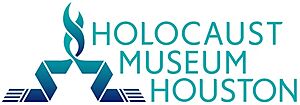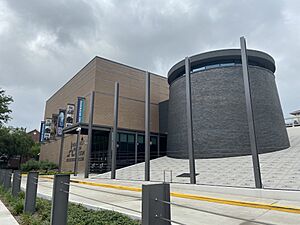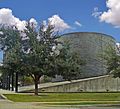Holocaust Museum Houston facts for kids
 |
|
 |
|
| Established | 1996 |
|---|---|
| Location | Houston, Texas |
| Type | Holocaust museum |
| Public transit access |
Red Line
Museum District |
The Holocaust Museum Houston is a special place in Houston, Texas. It teaches visitors about the Holocaust. The Holocaust was a terrible time in history. During this time, millions of Jewish people and others were persecuted and killed.
The museum helps us remember what happened. It also teaches us how to prevent such events from happening again. It is one of the largest Holocaust museums in the United States. The museum first opened its doors in 1996. The Boniuk Center at the museum is where the Education Department works. They create programs to help people learn.
Contents
Exploring the Museum
The Holocaust Museum Houston is a very important place. It helps people understand a difficult part of history. The museum teaches about the Holocaust and other times when groups of people were harmed. It shows how important it is to be kind and respectful to everyone.
What You Can See
The museum has many exhibits. These exhibits tell stories through pictures, videos, and items from the past. You can learn about the lives of people who lived during the Holocaust. You will also see how some brave people helped others.
Learning and Discovery
The museum is designed to help you learn. It has classrooms where students can study. There is also a research library if you want to learn even more. The museum has a theater for presentations and a café. It is a place for quiet thought and learning.
Museum's New Look
In June 2019, the Holocaust Museum Houston became much bigger. It expanded its original building in the Houston Museum District. The museum nearly doubled in size. It is now one of the largest Holocaust museums in the country.
More Space for Learning
The new building has three floors. It includes a welcoming area for visitors. There are four main galleries that tell the story of the Holocaust. Two other galleries show different exhibits that change over time. This means there is always something new to see.
Special Items on Display
During the expansion, some important items were moved for safety. These included a rescue boat named "Hanne Frank." There was also a real railcar. These items help visitors understand the experiences of people during the Holocaust. The museum now also talks about other genocides. A genocide is when a large group of people is killed, often because of their race or religion.
Images for kids
-
An old advertisement at the museum, showing cartoons by Arthur Szyk and Dr. Seuss from World War II
See also
 In Spanish: Museo del Holocausto (Houston) para niños
In Spanish: Museo del Holocausto (Houston) para niños






